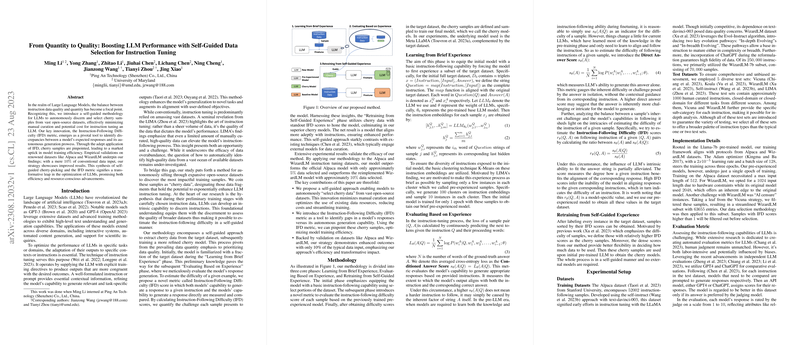Insights on Self-Guided Data Selection for LLMs Instruction Tuning
The paper "From Quantity to Quality: Boosting LLM Performance with Self-Guided Data Selection for Instruction Tuning" presents a novel methodology to enhance instruction tuning of LLMs by shifting focus from expansive data collection to high-quality data selection. Leveraging an innovative self-guided approach, the authors introduce the "Instruction-Following Difficulty" (IFD) metric, a pivotal tool to autonomously identify and select data samples, termed "cherry samples," from large open-source datasets.
The crux of this research lies in minimizing the dependency on vast datasets, which conventionally are used for instruction tuning. Instead, the paper demonstrates that only a small fraction of this data is required if selected judiciously using the IFD metric. Herein, the IFD metric measures the discrepancies between a model’s expected responses and its self-generated outputs, enabling efficient identification of critical data samples that can significantly improve model performance.
Methodology Overview
The authors' method unfolds in a three-phase approach:
- Learning from Brief Experience: In this phase, a subset of the data is used to equip the initial model with basic instruction-following capabilities. Instruction embeddings are utilized in clustering to identify a diverse and representative subset of the dataset.
- Evaluating Based on Experience: The IFD score is introduced as a metric for evaluating the difficulty of following instructions for each sample, calculated by the ratio of conditioned and direct answer scores. This score aids in separating the inherent complexity of the answer from the instructional difficulty, thereby guiding the model to focus on necessary instructional challenges.
- Retraining from Self-Guided Experience: Utilizing the established IFD scores, the model is retrained with cherry samples selected for their moderate IFD scores, providing a balanced optimization between confronting challenging tasks and enhancing learning efficiency.
Numerical Validation and Implications
The empirical results, tested on prominent datasets like Alpaca and WizardLM, underscore the efficacy of the proposed methodology. Notably, the paper reveals that merely 5% to 10% of the data, when selected through the self-guided approach, outperforms the full-dataset-trained models. This is a substantial claim that propels the discourse on data efficiency forward, emphasizing the importance of data quality over sheer quantity.
The proposed method has practical implications as it significantly reduces the cost and effort associated with manual data curation, making instruction tuning more resource-efficient. Theoretically, it prompts a reevaluation of current practices in LLM training, hinting at a broader applicability across different LLMs and datasets.
Future Directions
The paper paves the way for several avenues in future research, particularly in refining the IFD metric and expanding its applicability to diverse LLM architectures beyond the tested models. Furthermore, exploring automated mechanisms for instruction data generation, guided by model-specific difficulty assessments, could potentially revolutionize the domain of AI instruction tuning.
In conclusion, this research contributes a significant innovation in the evolving landscape of LLMs, advocating for a paradigm shift from quantity-centric to quality-focused data strategies. Its introduction of the IFD metric and demonstration of data efficiency sets a precedent for future methodologies aiming to optimize training processes for LLMs.
